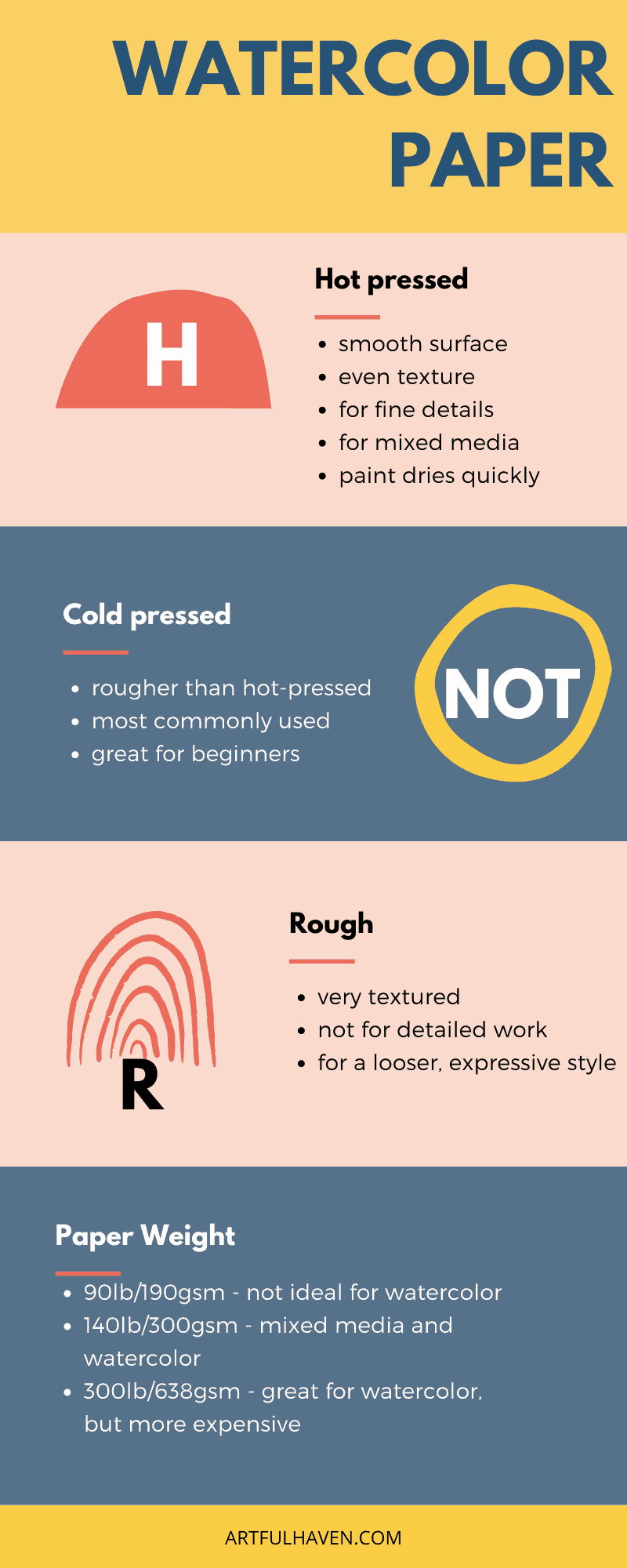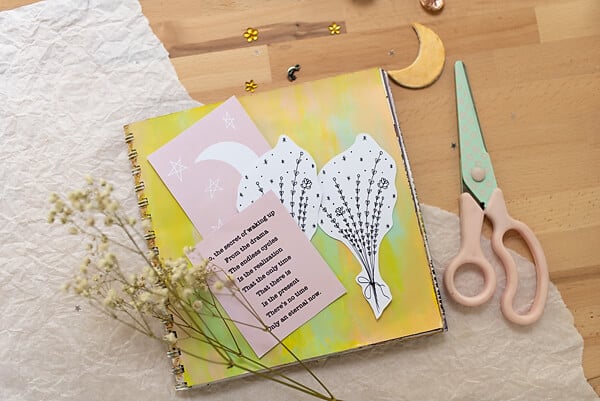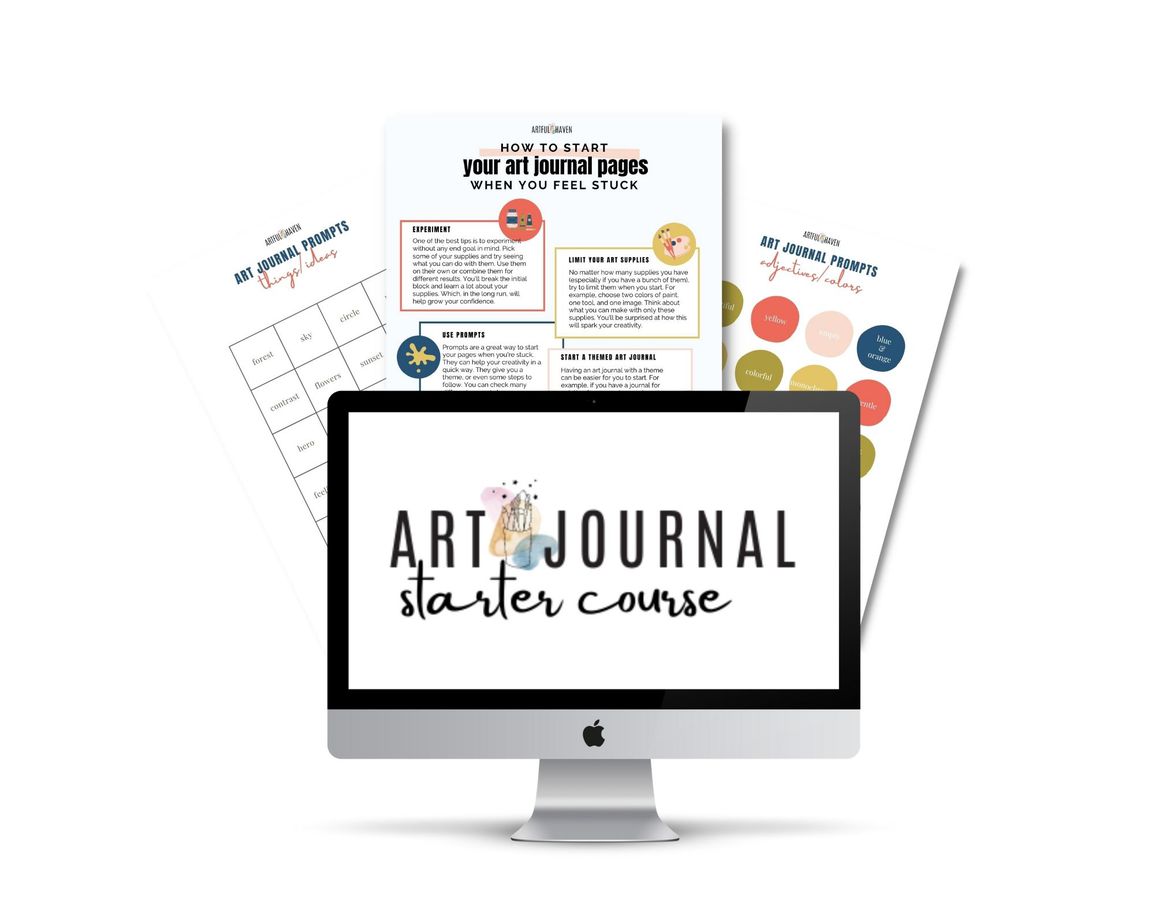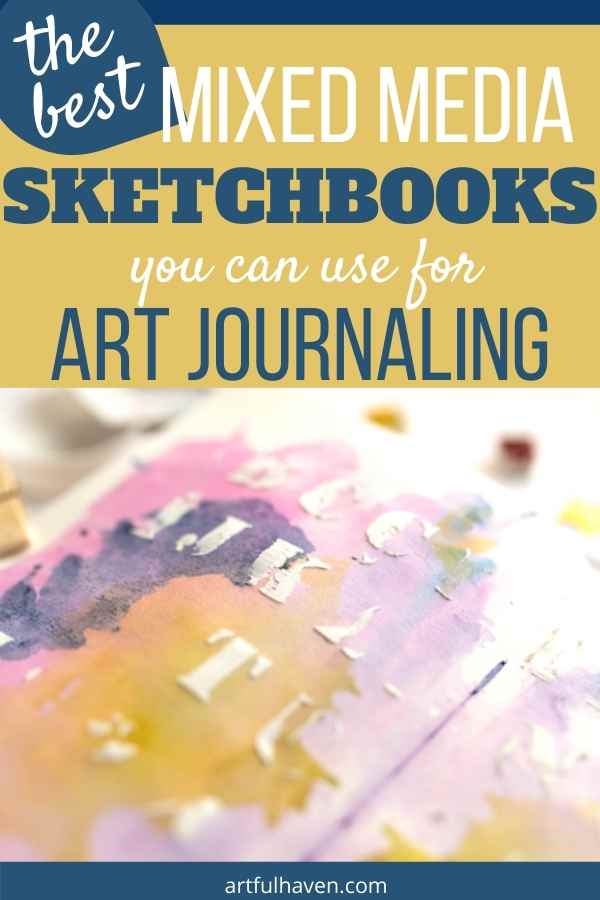Best Mixed Media Sketchbooks for Art Journaling (How to Choose the One for Your Style)
If you’re in search of the best-mixed media sketchbooks to turn into wonderful art journals, I bet you’ll find something you love on this list.
These sketchbooks have amazing paper quality, some are hardbound, some wire bound, there are different price levels among them, etc. You’ll get all the info in this blog post about each one and what you can use it for (what media and art supplies).
But first, let me share useful advice about deciding on the best-mixed media sketchbook for yourself.
What to have in mind when buying a mixed media sketchbook?
Of course, you won’t buy the first book that you get your hands on, right? Let’s dig into some characteristics of these sketchbooks you need to have in mind.
Quality of paper
I believe this is the most important thing to consider. Since you’ll be using it for mixed media art journaling, paper is super, super important.
Mixed media art requires using wet media, so you should consider the paperweight when buying.
What’s paperweight, you ask.
In laic terms, it’s the thickness of the paper. So, for example, printer paper and notebook paper are really thin and don’t handle wet media at all. However, mixed media and watercolor papers do the job much better. So, when buying a mixed media sketchbook, be sure it has mixed media or watercolor paper inside.
If you like numbers, the best paper weight for mixed media is at least 160 gsm. I love using 300 gsm when I really want to be aggressive with water.
Below, you’ll find quick info on watercolor and mixed media papers:

TIP: Don’t confuse mixed media and watercolor paper. A high quality, professional watercolor paper is pretty expensive and you don’t need that to play. So, when using watercolors on other types of paper, the paper might not handle it well. However, many kinds of mixed media paper handle light washes of watercolor, so you can still use it, but not aggressively.
Size
Yes, you should think about the size as well. For example, if you’re only a beginner, I suggest you don’t use a big sketchbook right away. Anything in the range of A5 will be great for you. Also, this size is convenient for carrying in your bag, to a friend’s house, to the beach, or to a nearby café.
When choosing your journal/sketchbook, always have in mind that when you open it, it doubles the size. This means that you get two pages in a spread/layout. So, imagine if you had an A4 size sketchbook, when you open it, you get double to work on. For a beginner, it might feel too much.
But, if you’re up to the challenge, why not? You can always work on one page at a time, and not spreads.
There are also smaller sketchbooks, like a Moleskine one I’ll tell you about later, that’s almost pocket-size. It’s amazing for carrying around in your bag.
Just take these things into consideration before you decide on the size, ok?
Binding

Sketchbooks and journals can be wire bound, hard bound, sewn, or plastic spiral.
The best thing about hardbound and sewn is that you can have a whole spread to work continuously on. The only problem can be if the binding is so stiff that the book doesn’t lay flat when you open it.
Spiral and wire binding is great for having the journal flat open. However, then you don’t have that continuous flow for a complete spread if that’s what you’re looking for. Sometimes wire binding can be big and not convenient for your hands or placing stencils evenly.
Finally, the plastic spiral isn’t strong enough in some journals and they can fall apart easily.
Consider these things to best suit your needs. Personally, I love the wire binding but also the hard-bound journals. Each of them has its own uniqueness and pros and cons. You need to see what is the best option for you.
Price
Yes, price is a determining factor for all of us. If a mixed-media sketchbook has high-quality paper, the price will be on the higher end.
Also, it’s common that journals with hard covers tend to cost more, but that also makes sense since a hardcover will protect your work better and is more durable.
You’ll see that the price of these sketchbooks ranges from very cheap to expensive ones. If you need to decide based on the price, don’t mind anything else but the paper, and then choose the best one for your budget.
Disclaimer: Some links in this post may be affiliate links. This means that if you purchase something through that link, I get a small commission, at no extra cost to you.
best mixed media sketchbooks
This pad consists of papers that are a bit thinner than the standard mixed media paper. This may be the reason it can’t hold too much water (when you paint with watercolors). The paper can sometimes wrinkle a bit. This doesn’t concern me at all, I’m used to paper wrinkling when I do mixed media. You shouldn’t worry about that too much either.
Well, this isn’t supposed to hold watercolors, it’s a drawing pad. But, the paper is thick enough for light layers of we media.
Also, markers can bleed through the paper, but most papers can’t hold markers, especially alcohol ones. That’s why there’s a whole separate production of marker paper.
It has a spiral binding which many artists love because it’s easy to flip the pages and the book stays flat when you create in it.
The price of these notebooks is a bit on the higher end, so bear that in mind.
One of the good things about the pad is that the papers are acid-free and have a rough texture on one side. This can be great for texture in your art. Also, it has a perforated cut line, so you can take out the sheets if you want to frame them or pass them on as gifts.
PROS
- rough and smooth pages
- pre-printed cut
- acid-free paper
CONS
- wrinkles at the excessive use of watercolor
- markers bleed
Arteza is a trusted brand by many artists, especially art journalists. I recently got this set from Amazon and immediately liked it. The set includes two books with the total of 128 pages. It’s pretty amazing.
The book is an A4 size which I usually don’t recommend to beginners but it’s such a wonderful book. The size is quite big, especially when you open it and get a large spread, but the paper is amazing. It’s 230 gsm paper which means you can use watercolors, acrylics, gouache, and other wet media without the fear of the paint bleeding.
Also, the sheets have a rough, textured side and a smooth side. The smooth side is good for drawing and sketching while the rough one is ideal for painting. But you can do both things on both sides.
However, the paper seems to absorb water quite quickly so if you want to paint a layered watercolor image, for example, be prepared that you won’t have much time to spread the paint and play with it. This doesn’t bother me at all for mixed media projects. Overall, it’s a good paper.
The books also have a pocket that is expandable where you can store cut-outs or other paper scraps. The elastic closure keeps the journal tightly closed so you can safely carry it around.
PROS
- rough and smooth pages
- 230 gsm paper
- number of pages
- expandable inner pocket
- great for watercolors and other wet media
- acid-free paper
- elastic closure
CONS
- the paper tends to soak water quickly
This pad seems a good choice for mixed media but the paper also doesn’t handle excessive use of watercolor well. Also, the exact size of the pages is smaller in reality than advertised.
However, it’s excellent for pencil drawing, and acrylics and has smooth and textured pages. It’s easy to fold and draw on the go because of the binding, which is sturdy enough to hold your book. Some spiral binding doesn’t let you turn the pages easily, but this one is the exception. It goes smoothly.
Also, the book has micro-perforated pages and you can take them out easily.
PROS
- rough and smooth pages
- pre-printed cut
- sturdy binding
- thick paper for mixed media
CONS
- wrinkles at the excessive use of watercolor
- papers smaller than advertised
This mixed media sketchbook is great for its number of pages. You get 120 pages which is really neat and can last you for a long time.
It has a sturdy cover which is also a big plus. The pages are micro-perforated but sometimes detach too easily.
As is the case with most of these sketchbooks, its paper can wrinkle if you use a lot of watercolor (read: water). Also, alcohol markers bleed through paper, but this is common for most papers. That’s why many companies produce marker paper separately.
PROS
- 120 pages
- pre-printed cut
- sturdy cover
CONS
- wrinkles at the excessive use of watercolor
- markers bleed
- pages sometimes detach too easily
Canson Artist Series Mix Media Paper Pad

- 5.5 in x 8.5. in (14 cm x 21.6 cm)
- wire bound
- 224 gsm
- 60 pages
This mixed media book has a smooth and textured side. The textured side can be great for colored pencils.
Its size makes it easily portable which is great if you want to make art on the go.
The weight of the paper is sufficient enough for mixed media, but again, not for aggressive use of watercolor that includes a lot of layering. For this, you’ll need watercolor paper.
The pages are pre-cut, so removing them is easy.
All in all, the book is great for painting and drawing as well.
PROS
- smooth and textured sides
- pre-printed cut
- portable size
- great paperweight
CONS
- wrinkles at the excessive use of watercolor
Canson XL Series Rough Mix Media

- 7 in x 10 in (17.8 cm x 25.4 cm)
- wire bound
- 185 gsm
- 100 pages
The paper will wrinkle slightly with watercolor, but it will hold really well if you don’t use too much water.
Its size is great for carrying around and can fit any backpack.
You can use ink, colored pencils, acrylic paint as well as other mixed media. It even doesn’t bleed that much with markers. It’s also good for drawing.
The paperweight isn’t as thick as some other sketchbooks, but it’s all right. Don’t be afraid to use paint on it.
PROS
- price is on the lower end
- size good for carrying around
- 100 pages
- good for most supplies
CONS
- wrinkles at the excessive use of watercolor
Strathmore Mixed Media Art Journal 500 Series Premium

- 8.5 in X 11 in (21.59 cm x 27.94 cm)
- hardbound
- 190 gsm
- 64 pages
This sketchbook has 100% cotton paper and it’s acid-free.
Its paper weight can hold almost any paint, but again, be careful with watercolor. Watercolors require a lot of water so it’s always like playing poker with them. I say you try with a little and see where it takes you. Everybody’s style is different.
You can try markers on this paper but not alcohol markers. They’re in the same basket as watercolors, they bleed 99% of the time if you don’t use them on marker paper.
The binding is also sturdy but you can sometimes have trouble laying it flat. When this happens, I just use paper clips and problem solved.
PROS
- acid-free paper
- good for most supplies
- sturdy binding
CONS
- wrinkles at the excessive use of watercolor
- doesn’t work well with alcohol markers
The paper inside is acid-free with a vellum finish and its weight promises good handling of paints. You can use acrylic paint, inks, gouache, and watercolor (again, be careful with the amount, wet on dry technique works best here).
The size is very good for traveling although some artists don’t love the small size.
I believe you can make a wonderful art journal from this mixed-media book. The wire binding lets you flip the pages easily, although some find the binding too big. Again, it’s all a matter of taste and habits.
PROS
- acid-free paper
- good for most supplies
- great for traveling
CONS
- maybe the size is too small for some artists
- big binding
This mixed media pad offers a great paper for acrylic paint. The weight of the paper is amazing, it’s thick enough to hold enough wet media. However, if you blend too hard with a paintbrush the top layers can come off. But this is true for most papers, just don’t be aggressive with your brushes.
Acrylic paint applies smoothly and dries fast which is what we all like. Also, it works great for pastels and you can even use alcohol markers (but test them out first before setting off to paint a large area).
The paper is even good for Gelli printing, pages come out easily although they aren’t pre-cut. And covers are easy to flip over.
PROS
- good paperweight
- good for most supplies
- useful for Gelli printing
CONS
- doesn’t hold too much brush rubbing
- glue bound pads may be frustrating to flip
This Strathmore mixed media pad has a smooth, stark white paper with 80 pages. The number of pages is really a great deal here.
It’s best used for mixed media sketches, the practice of techniques, and quick studies.
You can easily take the pages out because they’re pre-cut which is also a plus.
You can use wet media on it, especially acrylic paint. When it comes to watercolors, the paper accepts them nicely but still, be careful with the amount of water, or leave layers to dry before continuing.
Alcohol markers also work fine and the paper will bleed only after heavy application.
The book is also sturdy enough to carry around. And if you don’t like the front cover, you can always paint over it to suit your style.
PROS
- good paperweight
- number of pages (80)
- pre-cut pages
CONS
- can’t use a lot of water
- the cover isn’t thick enough
I’ve loved this watercolor journal ever since I first opened it. The size is great for traveling and carrying it around in your bag. The cover is sturdy enough for that and it has an elastic closure that keeps it from opening by accident.
This isn’t the only size Moleskine offers, so you can choose the one that suits your needs.
The paper is also very good. I’ve used it for sketching and watercolors and love it. Sometimes the paper will wrinkle just a tiny bit but after a while, it flattens out. The paper is smooth enough to keep detail in your work but textured enough to give depth and contrast. I love practicing my watercolor portraits or flowers in them.
However, sometimes I have a resist effect with watercolors. I believe that happens after I’ve used my eraser. It does something to the paper that makes it resist watercolors. This isn’t a big issue for an art journalist who likes practicing.
On another positive note, you can paint with watercolor on both sides of the paper with barely any show-through. Good enough.
Finally, the book lays flat when you create in it which is always a plus. And yes, it has a back pocket for storing your precious paper scraps.
PROS
- great paperweight
- good for different media
- portable size
- sturdy cover
- elastic closure
- back pocket
CONS
- weird resist effect
This mixed-media sketchbook comes in a set of three, which is amazing. So, you get 180 pages in total for under $20. Their size (A5) is perfect for beginners.
The paper is really thick and smooth. That’s why it’s great for sketching, pencil work, colored pencils, etc., and it holds pencil erasing really well. And its thickness allows you to use watercolors, acrylics, ink, etc. All in all, a great book for mixed media pages.
Also, it has perforated pages so you can easily detach them if you want to.
The only thing that might bother you is the wire binding which might get in the way while creating. But on the plus side, it can lay flat and you can flip the pages easily, and even fold it all the way to work one page only (great for outdoor art-making).
The paper might also curl if you use too much water, but you can even that out by closing the book and pressing it with something heavy overnight. Don’t stress over these things. You do mixed media for joy and self-expression, so little paper buckling really isn’t a big deal.
PROS
- great paperweight
- good for different media
- portable size
- good for drawing
- pre-cut pages
- price/pages ratio
CONS
- the cover is not sturdy enough
- the paper might curl a bit
choosing best-mixed media sketchbooks – final tips
There are a gazillion sketchbooks and journals you can use for mixed media. Many art journalists make their own from different kinds of paper. I don’t want you to stress over this and lose your mind figuring out which is the best.
The best-mixed media sketchbook for you is the one you choose based on the most important thing to you:
- paper quality
- size
- binding
- price
If you can’t take all four of these into account, I say choose according to the paper quality and price. I know that our art supplies budget isn’t always as big as we’d want it to be, so stay in the price range you can afford. Then, look for the best paper in that range. After that, you’ll have a perfect mixed media book for yourself.











